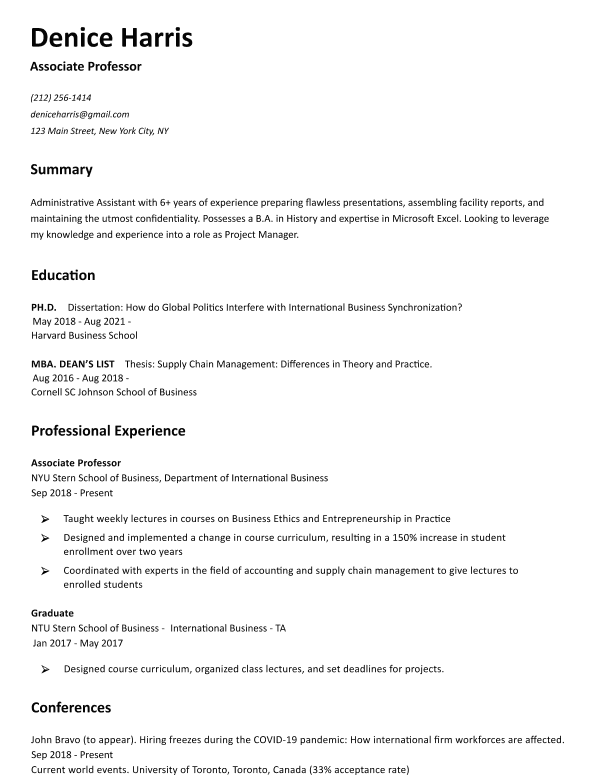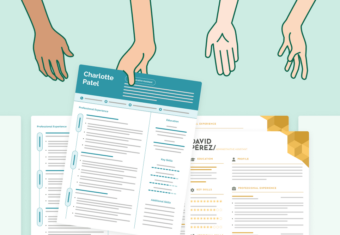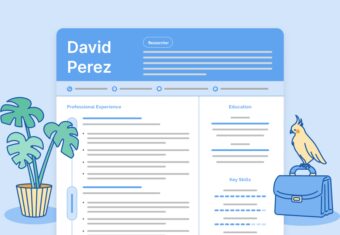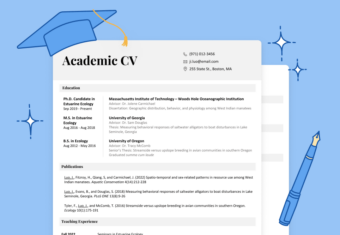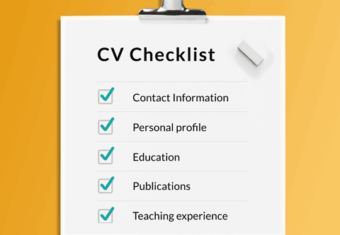A curriculum vitae (CV) is a document that gives a detailed overview of your academic and professional experience.
However, depending on the field and where you’re applying for a job, the meaning of “CV” may vary.
CV definition
CV stands for curriculum vitae, which is Latin for “course of life”. In the US and Canada, a CV is a document used by college professors, graduate students, and scientists to showcase their professional accomplishments and publications. As the name implies, your CV should be continuously updated throughout your life as your experience grows.
A CV (sometimes called an academic CV) outlines your profession-specific skills, work and teaching experience, and educational background, and is used in fields like academia, medicine, and research.
However, in most other countries around the world, a “CV” is the same thing as a resume. So if you’re getting conflicting information online about what a CV is, you’re probably reading a website run by people from the UK or Europe.
Our free-to-use cv builder can make you a cv in as little as 5 minutes. Just pick the template you want, and our software will format everything for you.
What CV means outside the US
In the UK, Europe, and New Zealand, a CV is the same thing as a resume, and typically summarizes your relevant work history, including your academic background and professional skills. This type of CV is commonly two pages long and is used to apply for any type of job – not just those in academia.
If you’re applying for jobs outside the US or Canada, research country-specific requirements and expectations for what documents you need to submit with a job application.
What is the difference between a CV and a resume?
CVs and resumes are different documents used to apply for open positions in different situations.
In the US, resumes are used to apply for most jobs, while CVs are used to apply for academic, research, and medical jobs. Here are some key differences between resumes and CVs:
| US Resume | US CV (Academic) |
|---|---|
| One page long in most cases | No page limit |
| Directly targets a job | Less tailored to the job |
| Standard resume sections | Additional sections like “publications" and "conferences” |
| Used for the vast majority of jobs | Used for academic, medical, and research roles |
When to use a CV
If you’re applying for a medical, academic, research, or international role, you’ll likely need a CV. Here’s a quick description of each that covers what you need to know:
- Medical CV: This is a longer CV that demonstrates all of your relevant degrees, licenses, and experience (both in residency and as a certified professional).
- Academic CV: An academic CV should be used to apply for positions in academia like research roles or professorships. You’ll need to showcase your publications, presentations, fellowships, and other relevant information. There is no CV length limit when applying for a job in academia.
- International CV: This is the standard document for international job applications. Although it will contain much of the same information as a resume, make sure you understand the UK-style CV formatting British employers are used to.
- Research CV: A research CV follows certain formatting conventions dependent on the field, and often extends across multiple pages. Use a multipage CV if your research experience is extensive and important for the position you’re applying to.
If you’re unsure what kind of document is appropriate for your job application, check what the job ad asks you to submit.
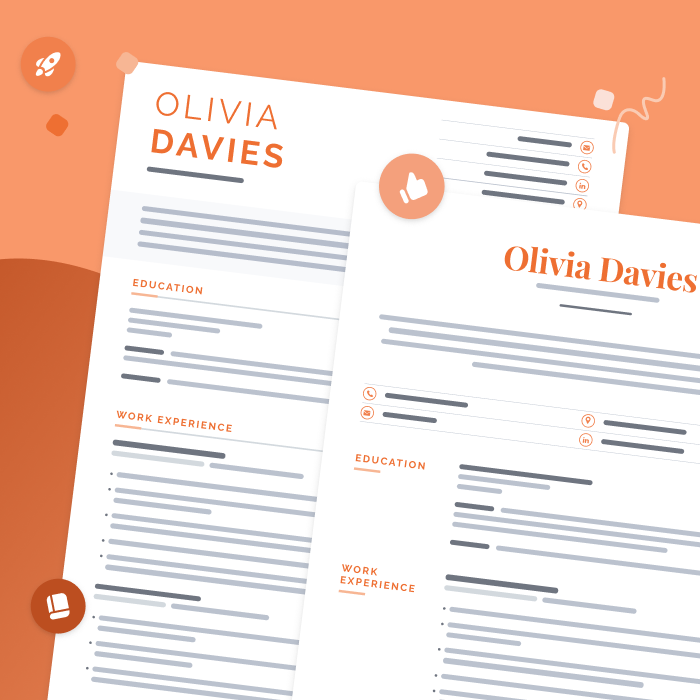
Need to make a CV? The best way to start is by downloading one of our free CV templates and filling it in with your information.
Tips for writing a CV
Wondering how to write a CV that impresses employers? Find out what goes on a CV and how to format it so that your experience shines with these tips:
1. Add the right information
Once you’ve covered the basics (education, relevant work experience, and updated contact info), showcase your academic background by making sure you know what to include on your CV.
Depending on your experience and preferences, consider adding the following sections to your academic CV:
- Relevant coursework
- Presentations
- Classes taught
- Grants
- Academic awards
- Research
- Published work
- Conferences
- Dissertations
- Licenses and certifications
- Sabbaticals
- CV references
Because CVs aren’t limited to one page, add as much relevant information as you need to represent your academic career.
2. Use a proper CV format
When it comes to putting all those sections together, choose a CV format that highlights your strengths as a candidate.
Which qualifications will impress employers the most – is it your publications or extensive teaching experience? Order your sections accordingly, keeping your strongest selling points on the first page where employers can easily see them.
For each section, list your experience in reverse chronological order, with your most recent experience at the top. And if any particular section gets too long, consider breaking it up into smaller sections. For example, if you have a long list of publications, you can organize them by type (books, conference papers, research papers, etc.).
Here are some additional formatting tips to make sure your CV looks professional:
- Keep all your margins between ½” and 1”
- Choose an easy-to-read font like Lato or Helvetica
- Use a font size between 10.5 and 12 points
3. Tailor your CV to your target position
If you’re applying to different types of positions, tailoring your CV to target each job can improve your chances of getting an interview.
When employers scan CVs, they’re looking for specific kinds of qualifications and experience. You can get noticed more easily by making sure that your CV includes all (or most) of the requirements listed in the job ad.
Spend some time reading the job listing and highlighting all of the key skills and experience it includes. Then, emphasize these skills and experiences in your CV using specific examples and achievements.
2 professional CV examples
Making a CV for the first time or entering a new industry? Here are a couple of helpful CV examples to show you what yours should look like.
Academic CV sample
Here’s an academic CV example for a Ph.D. student from Harvard:
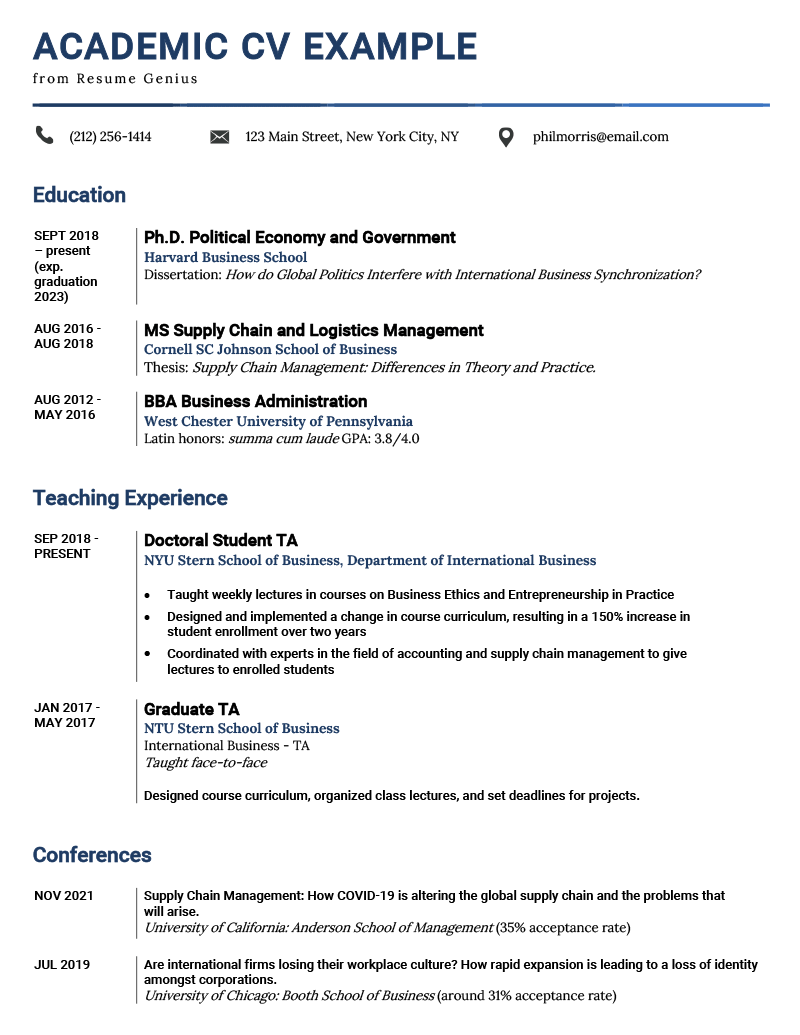
Medical CV sample
Below is an example of a CV for a nurse practitioner that you can look at to get ideas as you write your own application document.

If you’ve never written a CV, an online CV maker can guide you through the process quickly and easily.
When you start writing your CV, consider what information is most relevant to the position you’re applying for, and look at industry-based CV examples for guidance if you’re unsure what sections to include.




